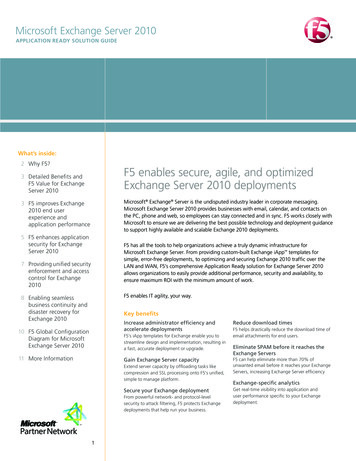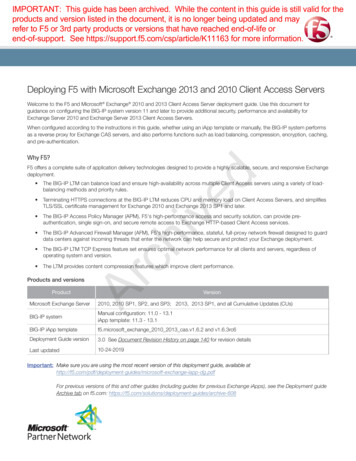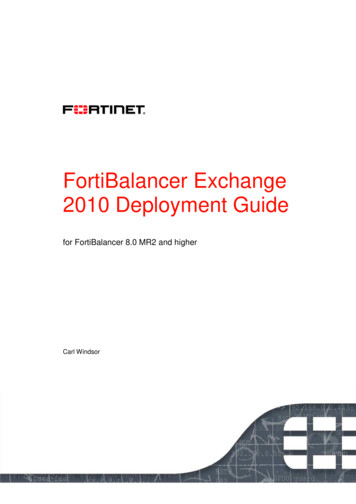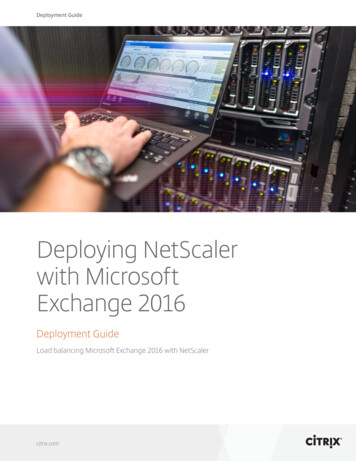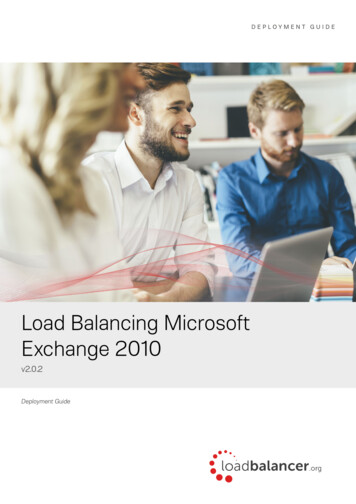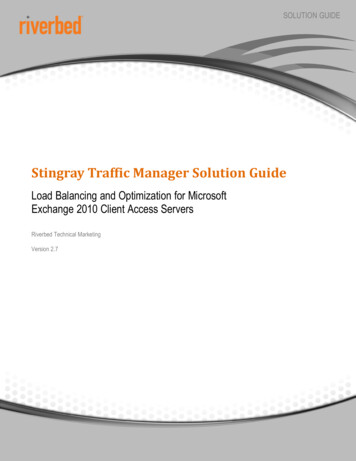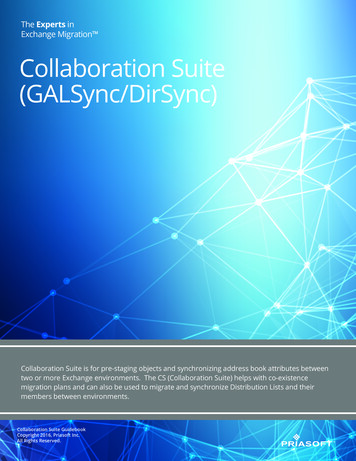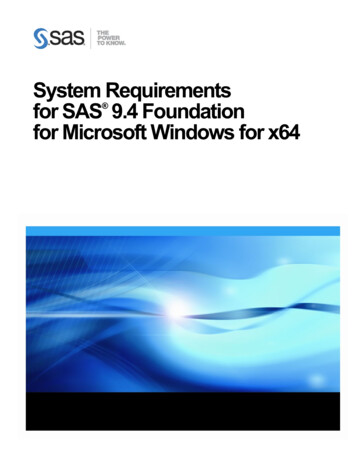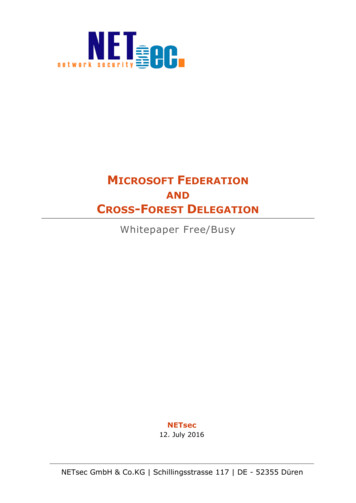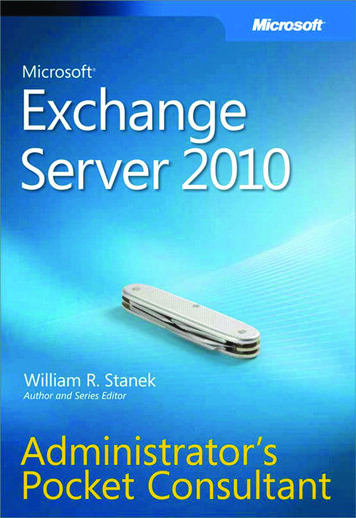
Transcription
Microsoft ExchangeServer 2010 Administrator’s Pocket ConsultantWilliam R. StanekA01T627123.indd 110/6/2009 8:10:41 AM
PUBLISHED BYMicrosoft PressA Division of Microsoft CorporationOne Microsoft WayRedmond, Washington 98052-6399Copyright 2010 by William StanekAll rights reserved. No part of the contents of this book may be reproduced or transmitted inany form or by any means without the written permission of the publisher.Library of Congress Control Number: 2009938146Printed and bound in the United States of America.1 2 3 4 5 6 7 8 9 WCE 4 3 2 1 0 9Distributed in Canada by H.B. Fenn and Company Ltd.A CIP catalogue record for this book is available from the British Library.Microsoft Press books are available through booksellers and distributors worldwide. Forfurther information about international editions, contact your local Microsoft Corporationoffice or contact Microsoft Press International directly at fax (425) 936-7329. Visit our Website at www.microsoft.com/mspress. Send comments to mspinput@microsoft.comMicrosoft, Microsoft Press, Access, Active Directory, ActiveSync, Entourage, Excel,Forefront, Hotmail, InfoPath, Internet Explorer, MS, MSN, Outlook, PowerPoint,SharePoint, Windows, Windows Live, Windows Media, Windows Mobile, Windows NT,Windows PowerShell, Windows Server, and Windows Vista are either registered trademarksor trademarks of Microsoft Corporation in the United States and/or other countries. Otherproduct and company names mentioned herein may be the trademarks of their respectiveowners.The example companies, organizations, products, domain names, e-mail addresses, logos,people, places, and events depicted herein are fictitious. No association with any realcompany, organization, product, domain name, e-mail address, logo, person, place, or event isintended or should be inferred.This book expresses the author’s views and opinions. The information contained in thisbook is provided without any express, statutory, or implied warranties. Neither the authors,Microsoft Corporation, nor its resellers, or distributors will be held liable for any damagescaused or alleged to be caused either directly or indirectly by this book.Acquisitions Editor: Martin DelReDevelopmental Editor: Karen SzallProject Editor: Carol VuEditorial Production: Macmillan Publishing SolutionsTechnical Reviewer: Todd Meister; Technical Review services provided by Content Master, amember of CM Group, Ltd.Cover: Tom Draper DesignBody Part No. X16-03279A02L627123.indd 210/6/2009 8:14:23 AM
ContentsChapter 1AcknowledgmentsxviiIntroductionxixExchange Server 2010 Administration Overview1Exchange Server 2010 and Your Hardware . . . . . . . . . . . . . . . . . . . . 3Exchange Server 2010 Editions . . . . . . . . . . . . . . . . . . . . . . . . . . . . . . 5Exchange Server and Windows . . . . . . . . . . . . . . . . . . . . . . . . . . . . . 11Services for Exchange Server11Exchange Server Authentication and Security14Exchange Server Security Groups15Exchange Server and Active Directory . . . . . . . . . . . . . . . . . . . . . . . 17Understanding How Exchange Stores Information17Understanding How Exchange Routes Messages18Using the Graphical Administration Tools . . . . . . . . . . . . . . . . . . . . 19Using the Command-Line Administration Tools . . . . . . . . . . . . . . . 22Chapter 2Deploying Exchange Server 201025Exchange Server Messaging Roles . . . . . . . . . . . . . . . . . . . . . . . . . . 26Understanding Exchange Server Messaging Roles26Deploying Mailbox Servers: The Essentials29Deploying Client Access Servers: The Essentials33Deploying Unified Messaging Servers: The Essentials36Deploying Transport Servers: The Essentials37Integrating Exchange Server Roles with Active Directory . . . . . . 39Using Hub Transport Servers with Active Directory39Using Client Access Servers with Active Directory40Using Unified Messaging Servers with Active Directory41What do you think of this book? We want to hear from you!Microsoft is interested in hearing your feedback so we can continually improve ourbooks and learning resources for you. To participate in a brief online survey, please 23.indd 310/13/2009 12:14:48 PM
Using Mailbox Servers with Active Directory41Using Edge Transport Servers with Active Directory41Integrating Exchange Server 2010 into ExistingExchange Organizations . . . . . . . . . . . . . . . . . . . . . . . . . . . . . . . . 42Preparing Active Directory for Exchange Server 201043Configuring Exchange Server 2010 for Use withExisting Exchange Organizations44Moving to Exchange Server 201046Running and Modifying Exchange Server 2010 Setup . . . . . . . . . 50Chapter 3Installing New Exchange Servers50Installing Exchange Server52Adding, Modifying, or Uninstalling Server Roles56Exchange Server 2010 Administration Essentials57Validating the Exchange Server Licensing . . . . . . . . . . . . . . . . . . . . 57Understanding Exchange Server 2010 Organizations . . . . . . . . . . 59Using Site-Based Routing Instead of Routing Groups59How Site-Based Routing Works60Using Configuration Containers Instead ofAdministrative Groups63Understanding Data Storage in Exchange Server 2010 . . . . . . . . 74Working with the Active Directory Data Store74Working with the Exchange Store75Working with the Exchange Server Message Queues78Using and Managing Exchange Server Services . . . . . . . . . . . . . . . 81Chapter 4Working with Exchange Services81Checking Required Services83Starting, Stopping, and Pausing ExchangeServer Services83Configuring Service Startup84Configuring Service Recovery85Customizing Remote Management Services86Using the Exchange Management Shell91Using Windows PowerShell . . . . . . . . . . . . . . . . . . . . . . . . . . . . . . . . 91ivIntroducing Windows PowerShell91Running and Using Windows PowerShell92ContentsA03T627123.indd 410/13/2009 10:11:09 AM
Running and Using Cmdlets95Running and Using Other Commands and Utilities96Working with Cmdlets . . . . . . . . . . . . . . . . . . . . . . . . . . . . . . . . . . . . . 97Using Windows PowerShell Cmdlets97Using Cmdlet Parameters100Understanding Cmdlet Errors101Using Cmdlet Aliases101Using the Exchange Management Shell . . . . . . . . . . . . . . . . . . . . . 103Chapter 5Logging Exchange Management Console Commands103Running and Using the Exchange Management Shell104Working with Exchange Cmdlets115Working with Object Sets and Redirecting Output116User and Contact Administration117Understanding Users and Contacts . . . . . . . . . . . . . . . . . . . . . . . . 117Understanding the Basics of E-Mail Routing . . . . . . . . . . . . . . . . . 119Managing User Accounts and Mail Features . . . . . . . . . . . . . . . . . 120Configuring the Exchange Control Panel120Accessing and Using the Exchange Control Panel121Finding Existing Mailboxes, Contacts, and Groups126Creating Mailbox-Enabled and Mail-EnabledUser Accounts128Understanding Logon Names and Passwords128Adding Mailboxes to Existing Domain User Accounts140Setting or Changing the Display Name and LogonName for User Accounts142Setting or Changing Contact Information forUser Accounts143Changing a User’s Exchange Server Alias andDisplay Name143Adding, Changing, and Removing E-Mail Addresses144Setting a Default Reply-To Address for a User Account145Changing a User’s Web, Wireless Service, andProtocol Options146Requiring User Accounts to Change Passwords147Deleting Mailboxes from User Accounts148Deleting User Accounts and Their Mailboxes148ContentsA03T627123.indd 5v10/13/2009 10:11:09 AM
Managing Contacts . . . . . . . . . . . . . . . . . . . . . . . . . . . . . . . . . . . . . . 149Chapter 6Creating Mail-Enabled Contacts150Mail-Enabling Existing Contacts152Setting or Changing a Contact’s Name and Alias153Setting Additional Directory Information for Contacts153Changing E-Mail Addresses Associated with Contacts154Disabling Contacts and Removing ExchangeAttributes155Deleting Contacts155Mailbox Administration157Creating Special-Purpose Mailboxes . . . . . . . . . . . . . . . . . . . . . . . 157Using Room and Equipment Mailboxes158Creating Room and Equipment Mailboxes160Creating Linked Mailboxes162Creating Forwarding Mailboxes165Creating Archive Mailboxes166Creating Arbitration Mailboxes167Creating Discovery Mailboxes168Creating Shared Mailboxes169Managing Mailboxes: The Essentials . . . . . . . . . . . . . . . . . . . . . . . . 169Viewing Current Mailbox Size, Message Count,and Last Logon170Setting Alternate Mailbox Display Names forMultilanguage Environments172Hiding Mailboxes from Address Lists172Defining Custom Mailbox Attributes for Address Lists173Moving Mailboxes . . . . . . . . . . . . . . . . . . . . . . . . . . . . . . . . . . . . . . . 173Moving Mailboxes: The Essentials173Performing Online Mailbox Moves175Configuring Mailbox Delivery Restrictions, Permissions,and Storage Limits . . . . . . . . . . . . . . . . . . . . . . . . . . . . . . . . . . . . 182viSetting Message Size Restrictions for Contacts182Setting Message Size Restrictions on Delivery toand from Individual Mailboxes182Setting Send and Receive Restrictions for Contacts183Setting Message Send and Receive Restrictionson Individual Mailboxes183ContentsA03T627123.indd 610/13/2009 10:11:09 AM
Chapter 7Permitting Others to Access a Mailbox184Forwarding E-Mail to a New Address186Setting Storage Restrictions on an Individual Mailbox187Setting Deleted Item Retention Time on IndividualMailboxes189Working with Distribution Groups andAddress Lists191Using Security and Distribution Groups . . . . . . . . . . . . . . . . . . . . . 191Group Types, Scope, and Identifiers191When to Use Security and Standard DistributionGroups193When to Use Dynamic Distribution Groups194Working with Security and Standard Distribution Groups . . . . . 195Creating Security and Standard Distribution Groups195Assigning and Removing Membership forIndividual Users, Groups, and Contacts200Adding and Removing Managers202Configuring Member Restrictions and Moderation203Working with Dynamic Distribution Groups . . . . . . . . . . . . . . . . . 205Creating Dynamic Distribution Groups205Changing Query Filters209Changing Filter Conditions209Designating an Expansion Server210Modifying Dynamic Distribution GroupsUsing Cmdlets210Previewing Dynamic Distribution Group Membership212Other Essential Tasks for Managing Groups . . . . . . . . . . . . . . . . . 212Changing a Group’s Name Information212Changing, Adding, or Deleting a Group’s E-MailAddresses213Hiding Groups from Exchange Address Lists214Setting Usage Restrictions on Groups214Setting Message Size Restrictions for Deliveryto Groups215Setting Out-of-Office and Delivery Report Optionsfor Groups216Deleting Groups216ContentsA03T627123.indd 7vii10/13/2009 10:11:09 AM
Managing Online Address Lists . . . . . . . . . . . . . . . . . . . . . . . . . . . . 217Using Default Address Lists217Creating and Applying New Address Lists218Configuring Clients to Use Address Lists222Updating Address List Configuration andMembership Throughout the Domain222Editing Address Lists223Renaming and Deleting Address Lists224Managing Offline Address Books . . . . . . . . . . . . . . . . . . . . . . . . . . 225Chapter 8Creating Offline Address Books225Configuring Clients to Use an Offline Address Book228Assigning a Time to Rebuild an Offline Address Book229Rebuilding Offline Address Books Manually229Setting the Default Offline Address Book230Changing Offline Address Book Properties230Changing the Offline Address Book Server231Deleting Offline Address Books232Implementing Exchange Server 2010 Security233Configuring Standard Permissions for Exchange Server . . . . . . . 233Assigning Exchange Server Permissions to Users,Contacts, and Groups234Understanding the Exchange Management Groups235Assigning Standard Exchange ManagementPermissions239Understanding Advanced Exchange ServerPermissions240Assigning Advanced Exchange Server Permissions242Configuring Role-Based Permissions for Exchange Server . . . . . 244Understanding Role-Based Permissions244Creating and Managing Role Groups249Viewing, Adding or Removing Role Group Members253Assigning Roles Directly or via Policy254Performing Advanced Permissions Management259Auditing Exchange Server Usage . . . . . . . . . . . . . . . . . . . . . . . . . . . 268viiiUsing Auditing268Configuring Auditing268ContentsA03T627123.indd 810/13/2009 10:11:09 AM
Configuring Compliance and Messaging Retention . . . . . . . . . . 270Chapter 9Understanding Message Retention Policies and Tags271Creating and Applying Retention Tags273Applying Records Management to a Mailbox Server275Managing Data and Database AvailabilityGroups277Navigating the Information Store . . . . . . . . . . . . . . . . . . . . . . . . . . 277Using Databases278Understanding Database Structures279Improving Availability282Introducing Active Manager285Creating and Managing Database Availability Groups . . . . . . . . 287Creating Database Availability Groups287Managing Availability Group Membership292Managing Database Availability Group Networks295Configuring Database Availability Group Properties301Removing Servers from a Database AvailabilityGroup303Removing Database Availability Groups304Switching over Servers and Databases304Content Indexing . . . . . . . . . . . . . . . . . . . . . . . . . . . . . . . . . . . . . . . . 307Understanding Indexing307Managing Exchange Store Search308Chapter 10 Mailbox and Public Folder DatabaseAdministration311Working with Active Mailbox Databases . . . . . . . . . . . . . . . . . . . . 311Understanding Mailbox Databases312Creating Mailbox Databases313Setting the Default Public Folder Database andDefault Offline Address Book316Setting Mailbox Database Limits and DeletionRetention317Recovering Deleted Mailboxes321Recovering Deleted Items from Mailbox Databases322ContentsA03T627123.indd 9ix10/13/2009 10:11:09 AM
Working with Mailbox Database Copies . . . . . . . . . . . . . . . . . . . . 323Creating Mailbox Database Copies324Setting Replay, Truncation, and PreferenceValues for Database Copies327Suspending and Resuming Replication327Updating Mailbox Database Copies329Monitoring Database Replication Status333Removing Database Copies337Using Public Folder Databases . . . . . . . . . . . . . . . . . . . . . . . . . . . . . 338Understanding Public Folder Databases338Creating Public Folder Databases338Setting Public Folder Database Limits340Configuring Public Folder Replication343Configuring Public Folder Referrals345Recovering Deleted Items from Public FolderDatabases347Managing Mailbox and Public Folder Databases . . . . . . . . . . . . . 348Mounting and Dismounting Databases348Setting the Maintenance Interval352Moving Databases353Renaming Databases355Deleting Databases355Chapter 11 Accessing and Managing Public Folders357Accessing Public Folders . . . . . . . . . . . . . . . . . . . . . . . . . . . . . . . . . . 357Accessing Public Folders in Mail Clients358Accessing Public Folders Through the InformationStore359Creating and Working with Public Folders . . . . . . . . . . . . . . . . . . 363xCreating Public Folders in Microsoft Outlook363Creating Public Folders Using the Public FolderManagement Console364Creating Public Folders Using the ExchangeManagement Shell365Determining Public Folder Size, Item Count, andLast Access Time366Adding Items to Public Folders Using Outlook368ContentsA03T627123.indd 1010/13/2009 10:11:09 AM
Managing Public Folder Settings . . . . . . . . . . . . . . . . . . . . . . . . . . . 372Controlling Folder Replication, Messaging Limits,Quotas, and Deleted Item Retention372Setting Client Permissions373Granting and Revoking Send As Permissionsfor Public Folders376Propagating Public Folder Settings and Data377Manipulating, Renaming, and RecoveringPublic Folders378Chapter 12 Managing Hub Transport and EdgeTransport Servers381Working with SMTP Connectors, Sites, and Links . . . . . . . . . . . . 382Connecting Source and Destination Servers382Viewing and Managing Active Directory Site Details383Viewing and Managing Active Directory SiteLink Details385Creating Send Connectors387Viewing and Managing Send Connectors392Configuring Send Connector DNS Lookups394Setting Send Connector Limits395Creating Receive Connectors397Viewing and Managing Receive Connectors403Connecting to Exchange 2003 Routing Groups407Completing Transport Server Setup . . . . . . . . . . . . . . . . . . . . . . . . 409Configuring the Postmaster Address and Mailbox409Configuring Transport Limits410Configuring the Transport Dumpster411Configuring Shadow Redundancy413Enabling Anti-Spam Features414Subscribing Edge Transport Servers416Configuring Journal Rules423Configuring Transport Rules425Managing Message Pickup, Replay, Throttling, andBack Pressure . . . . . . . . . . . . . . . . . . . . . . . . . . . . . . . . . . . . . . . . . 430Understanding Message Pickup and Replay430Configuring and Moving the Pickup and ReplayDirectories431ContentsA03T627123.indd 11xi10/13/2009 10:11:09 AM
Changing the Message Processing Speed432Configuring Messaging Limits for the PickupDirectory433Configuring Message Throttling434Understanding Back Pressure435Creating and Managing Accepted Domains . . . . . . . . . . . . . . . . . 436Understanding Accepted Domains, AuthoritativeDomains, and Relay Domains436Viewing Accepted Domains437Creating Accepted Domains438Changing the Accepted Domain Type and Identifier440Removing Accepted Domains441Creating and Managing E-Mail Address Policies . . . . . . . . . . . . . 441Viewing E-Mail Address Policies442Creating E-Mail Address Policies443Editing and Applying E-Mail Address Policies446Removing E-Mail Address Policies448Creating and Managing Remote Domains . . . . . . . . . . . . . . . . . . 448Viewing Remote Domains448Creating Remote Domains449Configuring Messaging Options for RemoteDomains451Removing Remote Domains453Configuring Anti-Spam and Message Filtering Options . . . . . . . 453Filtering Spam and Other Unwanted E-Mailby Sender453Filtering Spam and Other Unwanted E-Mailby Recipient455Filtering Connections with IP Block Lists456Defining Block List Exceptions and GlobalAllow/Block Lists460Preventing Internal Servers from Being Filtered464Chapter 13 Managing Client Access Servers467Managing Web and Mobile Access . . . . . . . . . . . . . . . . . . . . . . . . . 467Using Outlook Web App and Exchange ActiveSyncwith IISxii468ContentsA03T627123.indd 1210/13/2009 10:11:09 AM
Working with Virtual Directories and WebApplications469Enabling and Disabling Outlook Web App Features470Configuring Ports, IP Addresses, and Host NamesUsed by Web Sites472Enabling SSL on Web Sites473Restricting Incoming Connections and SettingTime-Out Values475Redirecting Users to Alternate URLs476Controlling Access to the HTTP Server477Throttling Client Access481Starting, Stopping, and Restarting Web Sites483Configuring URLs and Authentication for the OAB484Configuring URLs and Authentication for OWA485Configuring URLs and Authentication for ExchangeActiveSync486Configuring URLs and Authentication for ECP487Configuring POP3 and IMAP4 . . . . . . . . . . . . . . . . . . . . . . . . . . . . . 488Enabling the Exchange POP3 and IMAP4 Services488Configuring POP3 and IMAP4 Bindings490Configuring POP3 and IMAP4 Authentication492Configuring Connection Settings for POP3 andIMAP4494Configuring Message Retrieval Settings for POP3and IMAP4495Deploying Outlook Anywhere . . . . . . . . . . . . . . . . . . . . . . . . . . . . . 497Managing Exchange Server Features for MobileDevices . . . . . . . . . . . . . . . . . . . . . . . . . . . . . . . . . . . . . . . . . . . . . . 503Understanding and Using Autodiscover503Understanding and Using Direct Push505Understanding and Using Exchange ActiveSyncMailbox Policy506Understanding and Using Remote Device Wipe518Understanding and Using Password Recovery520Understanding and Configuring Direct File Access521Understanding and Configuring Remote File Access526Understanding and Using WebReady DocumentViewing528ContentsA03T627123.indd 13xiii10/13/2009 10:11:09 AM
Chapter 14 Exchange Server 2010 Maintenance,Monitoring, and Queuing531Understanding Troubleshooting Basics . . . . . . . . . . . . . . . . . . . . . 531Performing Tracking and Logging Activities in anOrganization . . . . . . . . . . . . . . . . . . . . . . . . . . . . . . . . . . . . . . . . . 535Using Message Tracking535Using Protocol Logging541Using Connectivity Logging547Monitoring Events, Services, Servers, and ResourceUsage . . . . . . . . . . . . . . . . . . . . . . . . . . . . . . . . . . . . . . . . . . . . . . . 549Viewing Events549Managing Essential Services552Monitoring Exchange Messaging Components554Using Performance Alerting556Working with Queues . . . . . . . . . . . . . . . . . . . . . . . . . . . . . . . . . . . . 561Understanding Exchange Queues561Accessing the Queue Viewer563Managing Queues . . . . . . . . . . . . . . . . . . . . . . . . . . . . . . . . . . . . . . . 564Understanding Queue Summaries and Queue States564Refreshing the Queue View565Working with Messages in Queues566Forcing Connections to Queues567Suspending and Resuming Queues567Deleting Messages from Queues567Chapter 15 Backing Up and Restoring ExchangeServer 2010569Understanding the Essentials of Exchange ServerAvailability and Recovery . . . . . . . . . . . . . . . . . . . . . . . . . . . . . . 569xivEnsuring Data Availability570Backing Up Exchange Server: The Basics572Creating a Disaster Recovery Plan Based onExchange Roles574Finalizing Your Exchange Server DisasterRecovery Plan575Choosing Backup and Recovery Options577ContentsA03T627123.indd 1410/13/2009 10:11:09 AM
Performing Backup and Recovery on WindowsServer 2008 . . . . . . . . . . . . . . . . . . . . . . . . . . . . . . . . . . . . . . . . . . 579Getting Started with Windows Server Backup579Backing Up Exchange Server on WindowsServer 2008580Performing a Full Server Recovery583Recovering Exchange Server585Performing Additional Backup and Recovery Tasks . . . . . . . . . . 590Using the Recover Server Mode590Cloning Edge Transport Server Configurations592Mounting Mailbox Databases on Alternate Servers593Chapter 16 Managing Exchange Server 2010 Clients595Configuring Mail Support for Outlook and WindowsLive Mail . . . . . . . . . . . . . . . . . . . . . . . . . . . . . . . . . . . . . . . . . . . . . 597Understanding Offline Address Books andAutodiscover597Configuring Outlook for the First Time598Configuring Windows Live Mail for the First Time603Configuring Outlook for Exchange605Adding Internet Mail Accounts to Outlookand Windows Live Mail605Repairing and Changing Outlook Mail Accounts606Leaving Mail on the Server with POP3 . . . . . . . . . . . . . . . . . . . . . . 608Leaving Mail on the Server: Outlook608Leaving Mail on the Server: Windows Live Mail610Checking Private and Public Folders with IMAP4and UNIX Mail Servers . . . . . . . . . . . . . . . . . . . . . . . . . . . . . . . . . 610Checking Folders: Outlook610Checking Folders: Windows Live Mail611Managing the Exchange Server Configuration inOutlook . . . . . . . . . . . . . . . . . . . . . . . . . . . . . . . . . . . . . . . . . . . . . 612Managing Delivery and Processing E-Mail Messages612Accessing Multiple Exchange Server Mailboxes616Granting Permission to Access Folders WithoutDelegating Access618ContentsA03T627123.indd 15xv10/13/2009 10:11:09 AM
Using Mail Profiles to Customize the Mail Environment . . . . . . . 620Creating, Copying, and Removing Mail Profiles621Selecting a Specific Profile to Use on Startup622Chapter 17 Managing Mobile Messaging Users623Mastering Outlook Web App Essentials . . . . . . . . . . . . . . . . . . . . . 623Getting Started with Outlook Web App624Connecting to Mailboxes and Public Folder Dataover the Web625Working with Outlook Web App626Mastering Mobile Device and Wireless Access Essentials . . . . . . 631Mastering Remote Mail and Outlook AnywhereEssentials . . . . . . . . . . . . . . . . . . . . . . . . . . . . . . . . . . . . . . . . . . . . 633Using Remote Mail and Outlook Anywhere633Creating Outlook Profiles for Dial-Up Connectionsto Corporate Networks634Configuring Outlook Profiles for Outlook Anywhere637Index641What do you think of this book? We want to hear from you!Microsoft is interested in hearing your feedback so we can continually improve ourbooks and learning resources for you. To participate in a brief online survey, please A03T627123.indd 1610/13/2009 10:11:09 AM
AcknowledgmentsTo Scott Schnoll, Darcy Jayne, Patricia Eddy, and the Microsoft Exchange team—youknow why, and thank you!Something wonderful and unexpected happened during the writing of thisbook, and I wanted to share this “happening” with readers. So here goes. WhenI began my research for Microsoft Exchange Server 2010 Administrator’s PocketConsultant back in 2008, I had no idea how challenging this project would be. Tosay that Exchange Server 2010 is completely different from its predecessors is aconsiderable understatement. Exchange Server 2010 represents a massive, top-tobottom overhaul of Exchange Server. Every corner of Exchange Server has beentweaked, updated, or replaced entirely. In fact, I’ll go so far as to say that ExchangeServer 2010 seems more like an entirely different product than a new release ofExchange Server.Exchange Server has evolved into a comprehensive messaging and collaborationplatform that is completely integrated with Active Directory and fully scalable tomeet the needs of the most demanding environments. What’s more, just aboutevery facet of Exchange Server 2010 is completely customizable, and many ofthe customizations can be performed only from the command line. With literallythousands of customizations and an extensive role-based architecture that caneasily span multiple servers even in small businesses, the challenge in writing aday-to-day administrator’s guide to Exchange Server 2010 lay in figuring out thebest approach to organizing the material as well as in identifying essential information so that I could provide you with the critical details in one portable, precise, andconcise guide.I’ve been writing about Exchange Server professionally since 1999. My firstExchange Server book was published in 2000, and I’ve since written several otherson Exchange 2003 and Exchange 2007. But I’ve never had the Exchange teamget behind a book 100 percent, and that’s what happened here. Not only did theExchange team get behind the book, but team members Scott Schnoll, DarcyJayne, and Patricia Eddy spent many hours providing deep technical insights andoffering suggestions for improving the book. Scott and Darcy in particular wereextremely helpful. Although we didn’t always agree, I am certain our meeting ofthe minds made for a much better book. Indeed, no one anywhere knows moreabout Exchange Server than the team that created it. If I am in some way consideredan Exchange guru, these folks are truly Exchange deities. So I want to thank theExchange team for their helpful insights and suggestions.With that in mind, I had to carefully review the text, making sure I organized thematerial appropriately, focused on the core topics, and included all the tips, tricks,xviiA04A627123.indd 1710/13/2009 10:13:59 AM
and techniques you’ve come to expect from Pocket Consultants. The result is thebook you hold in your hand, which I hope you’ll agree is one of the best practical,portable guides to Exchange Server 2010.As I’ve stated in other books, the team at Microsoft Press is top-notch. On thisproject, I worked with Carol Vu, Karen Szall, Martin DelRe, and others. Everyone wasgreat to work with and very supportive of my unique approach to this book. MartinDelRe in particular believed in the book from the beginning and was really greatto work with. Completing and publishing the book wouldn’t have been possiblewithout their help!Unfortunately for the writer (but fortunately for readers), writing is only onepart of the publishing process. Next came editing and author review. I must say,Microsoft Press has the most thorough editorial and technical review process I’veseen anywhere—and I’ve written a lot of books for many different publishers. JohnPierce was the project editor, Ro
Microsoft, Microsoft Press, Access, Active Directory, ActiveSync, Entourage, Excel, . books and learning resources for you. To participate in a brief online survey, please visit: . S Microsoft Exchange Server 2010 Administrator’s Poc
